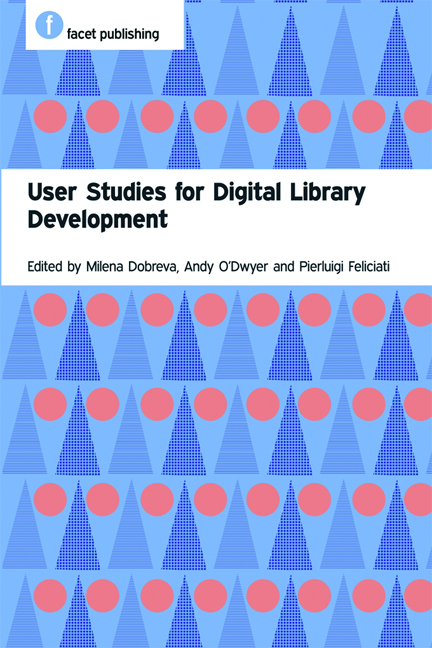Book contents
- Frontmatter
- Contents
- Preface
- Acknowledgements
- Abbreviations
- Glossary
- 1 Introduction: user studies for digital library development
- PART 1 SETTING THE SCENE
- 2 Models that inform digital library design
- 3 User-centric studies
- 4 Design issues and user needs
- 5 Users within the evaluation of digital libraries
- PART 2 METHODS EXPLAINED AND ILLUSTRATED
- PART 3 USER STUDIES IN THE DIGITAL LIBRARY UNIVERSE: WHAT ELSE NEEDS TO BE CONSIDERED?
- PART 4 USER STUDIES ACROSS THE CULTURAL HERITAGE SECTOR
- PART 5 PUTTING IT ALL TOGETHER
- Index
4 - Design issues and user needs
from PART 1 - SETTING THE SCENE
Published online by Cambridge University Press: 08 June 2018
- Frontmatter
- Contents
- Preface
- Acknowledgements
- Abbreviations
- Glossary
- 1 Introduction: user studies for digital library development
- PART 1 SETTING THE SCENE
- 2 Models that inform digital library design
- 3 User-centric studies
- 4 Design issues and user needs
- 5 Users within the evaluation of digital libraries
- PART 2 METHODS EXPLAINED AND ILLUSTRATED
- PART 3 USER STUDIES IN THE DIGITAL LIBRARY UNIVERSE: WHAT ELSE NEEDS TO BE CONSIDERED?
- PART 4 USER STUDIES ACROSS THE CULTURAL HERITAGE SECTOR
- PART 5 PUTTING IT ALL TOGETHER
- Index
Summary
Introduction
The last decade has been marked by rapid developments in the accessibility and usability of online digital resources. Their number and popularity are rapidly increasing; however, digital libraries (DLs) still pay tribute to the perception stereotyping of the traditional library, and this does not always work in their favour; moreover, DLs present material across different sectors, and using metaphors only from the traditional library world does not always accommodate the needs of museums, galleries, archives and other institutions. The only way to further improve DLs is to revisit the requirements inherited from the traditional understanding and to update them to the technological developments and to combine this with the emerging deeper knowledge on human information behaviour. This chapter offers a short comparison of some traditional libraries and DLs.
Design issues and DLs
As highlighted in Chapter 2, DLs work at multiple layers, where the human– computer interaction is very complex. This has a strong influence on user design, which should facilitate communication between the user and the system, providing support for a range of information behaviours. Indeed, in 2002 Katy Borner and Chaomei Chen started their list of core challenges associated with the design of visual interfaces for DLs with this one:
Research on any (visual) interface to DLs should be based on a detailed analysis of users, their information needs and their tasks.
(Borner and Chen, 2002)The DL design, however, has one more significant source to consult, and this is research in human–computer interaction, which has developed rapidly in the last decades. However, its advances are not embraced in the design of DLs, although the connection between usability and interface is long established. As early as 1999, Andrew Dillon suggested a qualitative framework for the usability evaluation of information resources, called TIME (Dillon, 1999), which included four elements: Task – what users want to do; Information model – what information structures best serve the intended use; Manipulation of materials – how users access the components of the document; and Ergonomics of visual displays – how these devices affect human perception of information (Dillon, 1999).
- Type
- Chapter
- Information
- User Studies for Digital Library Development , pp. 43 - 50Publisher: FacetPrint publication year: 2012



